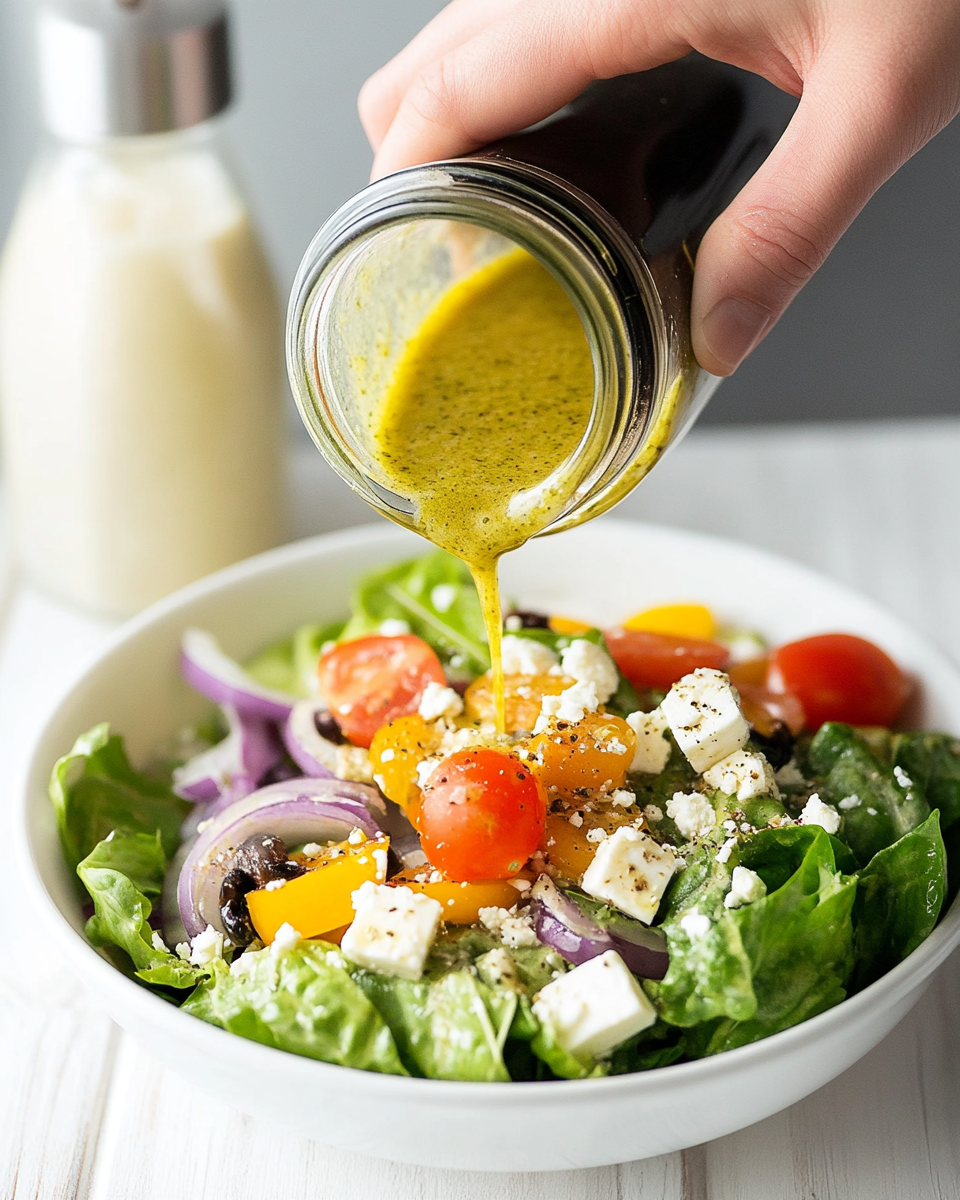This Best Greek Salad Dressing brings bold Mediterranean flavors to your table in just 5 minutes. It’s bright, tangy, and perfectly balanced with extra-virgin olive oil, fresh lemon, and aromatic herbs. This homemade Greek vinaigrette is not just ideal for classic Greek salads—it’s also a versatile marinade for chicken, shrimp, or roasted vegetables.

Unlike store-bought options, this dressing is made with fresh, simple ingredients. You control the flavor, texture, and salt content. With a clean, natural ingredient list, it’s a healthier and tastier alternative to bottled versions.
Why You’ll Love This Recipe
- Quick to make – Ready in just 5 minutes.
- Multi-use – Works as a dressing or marinade.
- Customizable – Add feta or keep it dairy-free.
- Authentic taste – Classic Mediterranean ingredients like lemon, olive oil, and oregano.
This Best Greek Salad Dressing adds vibrant flavor to every bite. Whether tossed with crisp lettuce and tomatoes or drizzled over grilled meats, it transforms everyday dishes into something special.
Tools You’ll Need
To make this recipe quick and easy, gather the following tools:
- Mason jar (with lid) – For mixing and storing the dressing.
- Citrus juicer – To extract fresh lemon juice.
- Microplane or zester – For capturing the lemon’s aromatic zest.
- Measuring cups and spoons – For accuracy and balance.
- Garlic press or sharp knife – For mincing garlic finely.
Why These Tools Matter
Each tool helps you achieve consistent flavor and proper texture. The jar makes shaking and emulsifying the dressing easy. The microplane ensures fine zest, which boosts citrus flavor. The garlic press produces an even mince, allowing the garlic to blend smoothly into the vinaigrette.
Preparation Tips
- Use high-quality extra-virgin olive oil for the richest flavor.
- Always choose fresh lemon juice over bottled versions.
- Mince garlic very finely to avoid overpowering bites.
- Add crumbled feta after shaking, not before, for better texture.
If refrigerating, allow the dressing to return to room temperature before using. Olive oil can solidify when cold, but a few minutes at room temperature or a quick microwave burst (no more than 10 seconds) brings it back to liquid form.
Ingredients
Here’s everything you’ll need to make the Best Greek Salad Dressing:
- ¾ cup extra-virgin olive oil
- Juice and zest of 1 large lemon (about ¼ cup juice)
- ¼ cup red wine vinegar
- 1 teaspoon Dijon mustard
- 1 teaspoon dried oregano
- 1 garlic clove, minced
- ¼ cup crumbled feta (optional)
- Salt, to taste (about ½ teaspoon)
- Freshly cracked black pepper, to taste (about ¼ teaspoon)
These ingredients come together to create a bold, zesty profile. The olive oil gives a smooth base, lemon adds brightness, vinegar provides acidity, and oregano offers a signature herbal note. Dijon mustard helps emulsify the mixture, keeping the oil and vinegar from separating.
Step-by-Step Instructions
Follow these simple steps to make the dressing:
- Combine ingredients
In a mason jar or any container with a tight-fitting lid, add:- Olive oil
- Lemon juice and zest
- Red wine vinegar
- Dijon mustard
- Dried oregano
- Minced garlic
- Shake well
Close the lid tightly. Shake the jar vigorously until all ingredients are fully emulsified. The mixture should look uniform and slightly thickened. - Add feta (optional)
If using feta, add it after emulsifying. Shake the jar again gently to distribute the cheese evenly without breaking it down too much. - Taste and adjust
Open the lid and taste the dressing. Add salt and freshly cracked black pepper to taste. Shake again to combine. - Serve or store
Use immediately or refrigerate for up to 3 weeks. Shake before each use, especially after storing.
Pro Tip
If your dressing separates in the fridge, just shake it well before serving. You can also leave it at room temperature for 10–15 minutes or microwave for a few seconds to re-liquify the olive oil.
Serving Suggestions
The Best Greek Salad Dressing is as versatile as it is flavorful. With its balance of tangy lemon, rich olive oil, and fragrant oregano, this dressing pairs beautifully with a variety of dishes. Whether you’re building a simple salad or marinating meat for the grill, its bold Mediterranean profile enhances everything it touches.
Classic Greek Salad
The most obvious and beloved use is on a classic Greek salad. Drizzle this vinaigrette over chopped romaine, juicy tomatoes, crisp cucumbers, red onions, Kalamata olives, and feta cheese. The flavors marry perfectly, creating a refreshing and well-balanced dish.
Marinated Grilled Chicken
Use the dressing as a marinade for chicken. Its acidity tenderizes the meat while infusing it with robust flavor. Let the chicken marinate for at least 30 minutes, then grill or roast it for a satisfying meal with Mediterranean flair.
Roasted Vegetables
Toss vegetables such as zucchini, bell peppers, red onions, or eggplant with a few tablespoons of the dressing before roasting. The oil and herbs add depth, while the lemon brightens the entire dish.
Grain Bowls and Pasta Salads
Mix the dressing into quinoa bowls, couscous, or pasta salads. It acts as both a flavor base and a moisture component, tying the ingredients together. It pairs especially well with chickpeas, olives, and roasted red peppers.
Pita Wraps and Sandwiches
Drizzle the dressing into wraps or sandwiches for a zesty punch. It complements grilled meats, falafel, or roasted vegetables and adds a delicious moisture layer without needing mayo or sauces.
Dip for Bread or Vegetables
Serve this dressing as a dipping sauce for warm pita bread, fresh vegetables, or even as a base for antipasto platters. Add a bit of extra feta and fresh oregano for a more substantial dip.
Common Mistakes to Avoid
Even with a simple recipe like the Best Greek Salad Dressing, small mistakes can affect the final flavor and texture. Here’s what to watch for.
Using Low-Quality Olive Oil
Olive oil is the foundation of this dressing. Using low-quality or heavily processed oil results in a flat or bitter taste. Always choose cold-pressed extra-virgin olive oil for the best results.
Skipping the Lemon Zest
Many people focus only on the juice, but the zest adds essential aromatic oils that amplify the lemon flavor. Use a microplane or zester to get the most out of the lemon without including the bitter white pith.
Not Emulsifying Properly
Failing to fully emulsify the dressing will result in separation. Ingredients will settle quickly, making it difficult to distribute the flavors evenly. Shake the jar vigorously or whisk thoroughly until the mixture is fully blended.
Overpowering with Vinegar
The balance between acid and oil is critical. Adding too much vinegar can make the dressing overly sharp. Stick to the recipe’s proportions and adjust carefully if you prefer a more acidic profile.
Forgetting to Taste and Adjust
Always taste the dressing before serving. Ingredients like garlic or vinegar can vary in intensity. Adjust the salt, pepper, or acidity to match your preference and the dish you’re serving.
Side Dishes That Pair Perfectly
This dressing enhances more than just salads. It complements many side dishes, making it a go-to addition for Mediterranean-inspired meals. Here are eight ideas to serve with the Best Greek Salad Dressing.
1. Lemon Herb Roasted Potatoes
Toss baby potatoes with the dressing before roasting. The lemon and oregano bring brightness, while the olive oil helps them crisp beautifully.
2. Couscous Salad with Vegetables
Combine cooked couscous with chopped cucumbers, tomatoes, parsley, and red onion. Add the Greek dressing for a refreshing side dish.
3. Grilled Halloumi Cheese
Slice and grill halloumi until golden, then drizzle the dressing over the warm cheese. The contrast of salty cheese and tangy dressing is irresistible.
4. Chickpea and Tomato Salad
Mix canned chickpeas with cherry tomatoes, diced red onion, and parsley. Toss with the dressing for a protein-packed, fiber-rich side.
5. Greek Orzo Pasta
Cook orzo pasta and combine with spinach, sun-dried tomatoes, and olives. Stir in the dressing while the pasta is warm to absorb the flavor.
6. Roasted Cauliflower
Roast cauliflower florets until golden brown. Finish with a drizzle of the dressing and a sprinkle of fresh herbs for a flavorful twist.
7. Pita Bread and Hummus
Serve warm pita triangles and hummus with a side of this dressing for dipping or drizzling. Add a few olives and sliced cucumbers to complete the plate.
8. Stuffed Grape Leaves
Also known as dolmades, these are filled with rice and herbs. The dressing complements their earthy, lemony flavor and adds a refreshing finish.
Expert Recipe Tips
To get the most flavor and longevity from your Best Greek Salad Dressing, follow these expert tips. These small adjustments make a big difference in taste and texture.
Use High-Quality Olive Oil
The olive oil forms the base of this dressing. A good-quality extra-virgin olive oil enhances the flavor, offering fruitiness and slight peppery notes that pair perfectly with lemon and herbs.
Add Feta Just Before Serving
If you’re using feta, add it just before serving. While it’s safe to store feta in the dressing, it can break down over time and change the consistency. For a fresher texture and cleaner appearance, mix it in as needed.
Emulsify for Best Texture
Use Dijon mustard to bind the oil and vinegar. This creates a stable emulsion and prevents the dressing from separating quickly. Shake the jar vigorously each time before serving to maintain the smooth consistency.
Adjust to Taste
The balance of acidity and salt varies based on preference. Add more lemon juice for brightness, or increase vinegar for more tang. Taste after mixing and adjust salt and pepper as needed.
Make it Creamier
If you prefer a creamy texture, whisk in a tablespoon of Greek yogurt. This variation works well for drizzling over grain bowls or hearty salads with roasted vegetables.
Flavor Enhancers
Consider adding a pinch of crushed red pepper flakes for heat, a splash of honey to balance acidity, or finely chopped fresh herbs like parsley or basil for added depth.
Storage Instructions
Refrigeration
Store your Best Greek Salad Dressing in a tightly sealed container or mason jar in the refrigerator. It keeps well for up to 3 weeks.
Because of the olive oil, the dressing may solidify when cold. This is normal and doesn’t affect the quality. Let it sit at room temperature for about 10 to 15 minutes, or microwave it for 5 to 10 seconds. Avoid overheating to preserve the flavor.
Re-Mixing Before Use
Before each use, shake the jar well to re-emulsify the ingredients. If you’ve added feta, shake gently to avoid breaking the cheese down too much.
Do Not Freeze
Freezing is not recommended. The texture and flavor of olive oil and acidic components degrade after thawing. For best results, make a fresh batch as needed.
Frequently Asked Questions (FAQs)
How long does homemade Greek salad dressing last?
When stored in the refrigerator in an airtight container, this dressing can last up to three weeks. Always shake before serving and check for changes in smell or appearance.
Can I make this dressing without Dijon mustard?
Yes. While Dijon mustard helps emulsify the dressing, you can leave it out. You may need to shake more vigorously to keep the ingredients combined.
Is Greek salad dressing healthy?
Yes. This dressing uses simple, whole ingredients with no preservatives or added sugars. Extra-virgin olive oil provides healthy fats, and lemon juice offers vitamin C and antioxidants.
Can I use this as a marinade?
Absolutely. The acidity in the lemon and vinegar makes it ideal for marinating chicken, shrimp, or vegetables. Use it as a marinade for at least 30 minutes, but no more than 2 hours for delicate proteins like shrimp.
What should I do if the dressing separates?
Separation is normal, especially after refrigeration. Let it sit at room temperature, then shake well before use. The Dijon mustard helps delay separation, but always shake before serving.
Is this dressing suitable for special diets?
Yes. This Best Greek Salad Dressing is gluten free and vegetarian. To make it dairy free, simply omit the feta cheese.
Can I double the recipe?
Yes. This dressing scales easily. Double the ingredients and store the extra in a larger mason jar. Just make sure to shake well before every use.
What type of vinegar works best?
Red wine vinegar provides a traditional Greek flavor and balances well with lemon juice. However, you can substitute with white wine vinegar or apple cider vinegar if needed.
Conclusion
The Best Greek Salad Dressing is more than a condiment—it’s a versatile, healthy staple that enhances countless dishes. Made with fresh, Mediterranean ingredients, it adds bold, zesty flavor whether tossed with crisp greens, used as a marinade, or served alongside roasted vegetables.
With proper storage and a few customizable variations, you’ll find yourself returning to this dressing again and again. It’s quick to make, easy to adjust, and pairs beautifully with nearly any meal.
For more ideas, check out these related recipes:
Best Greek Salad Dressing
Ingredients
- ¾ cup extra-virgin olive oil
- Juice and zest of 1 large lemon about ¼ cup juice
- ¼ cup red wine vinegar
- 1 teaspoon Dijon mustard
- 1 teaspoon dried oregano
- 1 clove garlic minced
- ¼ cup crumbled feta optional
- Salt to taste (about ½ teaspoon)
- Freshly cracked black pepper to taste (about ¼ teaspoon)
Instructions
- In a pint jar (or any jar with a tight-fitting lid), combine the olive oil, lemon juice, lemon zest, red wine vinegar, Dijon mustard, oregano, and minced garlic.
- Cover the jar and shake well until the dressing is fully emulsified.
- If using, add the crumbled feta to the jar, then shake again to distribute evenly.
- Taste the dressing and season with salt and freshly cracked black pepper, adjusting to your preference.
- Use immediately or store in the refrigerator for up to 3 weeks.




Leave a Comment